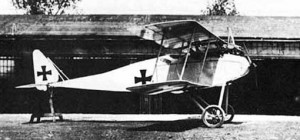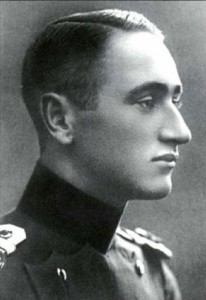The third preview article of the Wings of Glory WW1 Airplane Packs features the Halberstadt D.III, a fighter biplane used by the Luftstreitkräfte (Imperial German Army Air Service). The Halberstadt D.III was a variant of the D.II, used on the Western Front in late 1916, early 1917, succeeding the Fokker E.III Eindecker, which was already presented in the first article of this preview series (the other aircraft featured was the Morane Saulnier Type N).
The production version of the experimental D.I., the D.II was lighter, in order to improve the performance, and featured staggered wings and a more powerful 120 hp Mercedes D.II engine. The side and frontal radiators that had been tried in the D.I were replaced by a wing mounted radiator, similar to that later used on the Albatros D.III and on the D.V. The two bay wings were very strongly braced, with the trailing edge a wooden member, as opposed to the wire common on contemporary German aircraft.
The D.II entered in service in June 1916 and was soon followed by the D.III and D.IV models. Initially employed in escort duties, being assigned to the ordinary reconnaissance units of German air force, following these aircrafts were operated by small specialized fighter units - – the Kampfeinsitzerkommandos. They were the best aircraft available in mid-1916, when the first true fighter Jagdstaffeln were formed.
The Halberstadt fighter’s speed and climb were little better than the Eindecker’s, and inferior to such Allied contemporaries as the Nieuport 11 and the D.H.2. Even so, it was the preferred mount of the pilots of the early Jagdstaffeln, until the Albatros D.I became available.
The D.III was equipped with an Argus As.II 90 kW (120 hp) straight-six engine, which differed from the usual Mercedes D.II power plant in having its camshaft in the engine block, and using pushrods to operate the overhead valves, rather than having a camshaft running atop all of the cylinders as in a single overhead cam engine.
A total of 50 D.III examples were built by Halberstadt. As the new Albatros fighters came into service, the Halberstadts were quickly replaced and after the withdraw from combat, these aircrafts were used as trainers for the rookie pilots.
The Wings of Glory WW1 Airplane Packs will feature three versions of the Halberstadt D.III: the airplane flied by the Leutnant Hans von Keudell and other two aircrafts used by the Luftstreitskräfte, one of them with a camouflage color scheme.
Hans von Keudell
Credited with 11 victories, the Leutnant Hans von Keudell was born in April 1892 and studied in Berlin. He started his military career in 1904, as a cadet at Bensberg, and in 1911 he joined the Kaiser Alexander II von Russland Uhlan Regiment #3, with which he served in combat in Poland and France, until to be transferred to the German Air Force, in June 1915.
After a period of training as a two-seater pilot, von Keudell was assigned to the Breiftauben Abteilung Ostende, in December 1915, to fly bombing missions. He took part in the Verdun offensive and flew missions over Toul and Dunkirk. Then in the summer of 1916 he was trained as a fighter pilot and joined the single-seat fighter command KEK B, but was reassigned to Jasta 1 that month, when it was formed. Von Keudell reached his first victory August 31st, when he shot down a Martinsyde G.100 Elephant over Beaumetz, northern France.
At Jasta 1, flying the fighters Fokker D.I, Halberstadt D.III and Albatros D.III, he reached other 10 victories from September 1916 to January 1917- his eleventh victim on January 24th, 1917 was a Sopwith Pup. On February 5th, 1917, he left the Jasta 1 to raise and command the Jagdstaffel 27, but he was killed in action 10 days later, flying a Albatros D.III. There are evidences that he shot down a Nieuport 17 before to be defeated, scoring the first win of Jasta 27 and his 12th and last victory.
The Halberstadt D.III piloted by von Keudell was identifiable by his initial K depicted in black on the fuselage side.

Manfred von Richthofen with Ltn. von Gerstenberger in front of the Halberstadt D.III he used to fly to his home in May 1917
Information sources: The Aerodrome, Wikipedia, Over the Front, "Halberstadt Fighters" (Peter M Grosz, Windsock publications Classics of WW1 Aviation).










